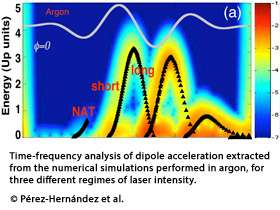Water window imaging opportunity

Ever heard of the water window? It consists of radiations in the 3.3 to 4.4 nanometre range, which are not absorbed by the water in biological tissues. New theoretical findings show that it is possible to develop coherent radiations within the water window. These could be the basis of an optimal technique to obtain a high-contrast image of the biological samples or to be used in high-precision spectroscopy.
Now, a new theoretical study identifies the physical mechanism needed to efficiently generate the harmonic radiations—which are multiples of an incoming laser's frequency—at high laser intensities that occur beyond the saturation threshold of atoms and molecules. These , aimed at improving conventional methods of coherent radiation production to reach the water window, were recently published in the EPJ D by José Pérez-Hernández from the Centre for Pulsated Laser, CLPU, in Salamanca, Spain, and colleagues.
When an intense and short laser pulse interacts with an atom or molecule, one of the resultant physical processes is the High-order Harmonic Generation (HHG) process, which is capable of changing the driving laser pulse into new harmonic frequencies. HHG also provides a direct way to synthesise atto-second pulses (10-18s range) and produce coherent radiation in the extreme UV range, dubbed XUV and EUV.
In previous similar work, studies focused on hydrogen as the atomic target. In the present work, the authors extend the study to argon atoms—a gas typically providing a high enough frequency conversion efficiency to detect the HHG. The authors use the same formalism as in hydrogen studies, consisting in mathematical equations combined with a quantum mechanical approach using numerical computation and providing a quantitative description of the HHG spectrum. The experimental confirmation of the reported prediction, however, still remains a challenge.
More information: Pérez-Hernández, J. A. et al. (2014). High order harmonic generation at high laser intensities beyond the tunnel regime. European ������Ƶical Journal D.
Journal information: European ������Ƶical Journal D
Provided by Springer





















